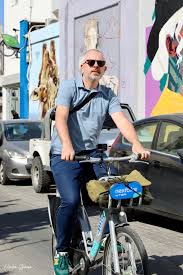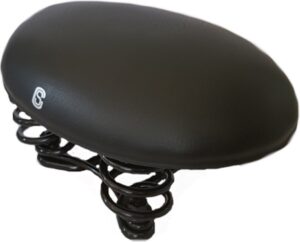 I have been in the Netherlands nearly a month now, following the adventures of Chris Brunlett of the Dutch Cycling Embassy while making my own discoveries of the country and its cycling culture.
I have been in the Netherlands nearly a month now, following the adventures of Chris Brunlett of the Dutch Cycling Embassy while making my own discoveries of the country and its cycling culture.
Recently, Chris did a piece on why the Dutch don’t wear helmets, and it deserves a response.
First, look carefully at Chris’ posture here. He is fully upright, his weight entirely on his backside. That’s a feature of Dutch cycling I had not appreciated before I got here.
My Edison e-bike, like the road bike I formerly rode, requires me to lean forward a little. This puts some load on my hands, so I wear gloves. It puts some load on my feet, so I stand while going over the worst of Atlanta’s bumpy roads. It also puts some load between my thighs.
I have found that Dutch cycling is much safer for the Dutch cyclist. Those red Dutch bike paths you see on Facebook? They’re smooth as glass, an absolute pleasure. (You should know they’re not all like that.) I am more alert to traffic while Dutch cycling, and there’s a lot of bike traffic to be alert for.
But my speed is lower, limited by the Dutch e-bike’s rules to 15 mph (25 kph) under power. Better vision, slower speeds, and great infrastructure combine to make riding here a ton of fun for Opa Fiets, as I’ve dubbed myself.
Making Adjustments

But what’s more important is that it’s tough to do a long ride in the Dutch style. Again, that’s because of weight distribution. On the typical hard Dutch saddle, 10 km (6 miles) is a bit of a stretch. That will get you across town in the Netherlands. It doesn’t get you home in Atlanta.
I’ve adjusted to upright Dutch cycling by borrowing a saddle from a friend named Paul. He’s an ex-pat whom I met on Facebook. He lives with his wife in Utrecht and fixes bicycles as part of his retirement.
Paul lent me a “noseless” saddle, like the one here. Springs give good comfort, but again there’s a limit. I rode out to Mijdrecht early this week, 27 miles (43 km) in all, stopping for lunch along the way. I was still hurting when I came in, and you know where.
There were few Dutch style cyclists on that road, except near towns. For just the reason I’ve stated. Dutch style cycling lacks comfort at long distances. The cyclists traveling long distances are real bikers, riding real road bikes at high speed, clad in Spandex and usually wearing helmets.
Making Holland Happen

That means in Atlanta, Dutch cycling becomes a tool to promote density.
The opposition to density is fierce because we don’t have it. It’s scary. People protest any development smacking of density asking, “where are people going to park?” Good restaurants close because, they say, there isn’t enough cheap parking nearby.
Cheap parking is the enemy of dense development. Car dependence militates against density, and 95% of Atlantans are entirely car dependent.
Opa Fiets, however, now knows what he’s fighting for when he gets home.









